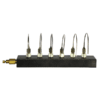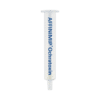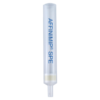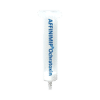Ochratoxin A
Ochratoxin A (OTA) is a mycotoxin produced as a secondary metabolite of various Aspergillus and Penicillium fungis. It can be found on several commodities (e.g. cereals and cereal-based products, coffee, beer, grape juice, wine, cacao products).
Ochratoxin A exhibits toxicity in animals and mankind, including nephrotoxic, hepatotoxic, immunotoxic, teratogenic and carcinogenic effects and represents therefore a serious health risk to livestock and population. In order to limit these effects, European Regulation (EC) 1881/2006 sets maximum levels for Ochratoxin A in foodstuffs (e.g. 5μg/kg in raw cereal grains, 30μg/kg in spices).
You can find here several application notes as well as articles using AFFINIMIP® SPE Ochratoxin A in various matrix such as cereals, wines, … as well the automatisation of its analysis. Flangeless cartridges are adapted to the main automate on the market.
- Mycotoxins /
- Ochratoxin A
Application note AFFINIMIP® SPE Ochratoxin A Automated Protocol (GILSON GX271 ASPEC™)
Automated protocol for Analysis of Ochratoxin A
The combination of AFFINIMIP® SPE Ochratoxin A SPE cartridges with an automate GILSON GX-271 ASPEC™ shows accurate and reliable analysis (CV 1.7% vs CV 2.5% in manual mode).
- Mycotoxins /
- Ochratoxin A
Application note AFFINIMIP® SPE Ochratoxin A Red and White Wines
Analysis of Ochratoxin A Red & white wines
Ochratoxin A concentrations in red and white wines were determined after pre-treatment with AFFINIMIP® SPE Ochratoxin A. High recovery yields were obtained via a very simple protocol.
- Mycotoxins /
- Ochratoxin A
Application note AFFINIMIP® SPE Ochratoxin A Cereals and Spices
Analysis of Ochratoxin A in Cereals and spices
Ochratoxin A analysis has been carried out on Wheat and several spices (Paprika, grey Pepper). After cleanup and concentration with AFFINIMIP® SPE Ochratoxin A, recovery yields higher than 90% (concentration: 30µg/Kg) were obtained except for Grey Pepper (73% for a concentration of 5µg/Kg).
- In this article, a method of analysis Ochratoxin A in edible tissues was developed and validated in pig complex matrix. With this very simple method, very sensitive LOD and LOQ respectively 0.001 and 0.003 μg/kg were obtained thanks to a cleanup with AFFINIMIP®SPE Ochratoxin A.
A rapid HPLC-FLD method for Ochratoxin A detection in pig muscle, kidney, liver by using enzymatic digestion with MISPE extraction, Giacomo Luci, MethodsX, Volume 7, 100873 (2020). Open access.
- Sensitive quantitation of Ochratoxin A in cocoa beans using differential pulse voltammetry based aptasensor, R. K. Mishra, A. Hayat, G. Catanante, G. Istamboulie, J.-L. Marty, Food Chemistry 192, 799-804, 2016.
- Estado-da-arte na análise cromatográfica de Ocratoxina A em amostras de alimento, Mariane A. Andrade, Fernando M. Lanças, Scientia Chromatographica ; 7(1):31-52 2015 (In portuguese, free access)
- Solid-phase extraction using molecularly imprinted polymer for determination of ochratoxin A in human urine, L. Xie, P. Sheng, W. Kong, X. Zhao, Z. Ou-Yang and M. Yang, World Mycotoxin Journal, 8 (1): 37-44, 2015. (article also in chinese in free access)
- Modelling of ochratoxin A photo-degradation by a UV multi-wavelength emitting lamp, R. Ibarz, A. Garvín, E. Azuara, A. Ibarz, LWT – Food Science and Technology, 61, 385 – 392, 2015.
- Molecularly imprinted polymer-based solid phase clean-up for analysis of ochratoxin A in ginger and LC-MS/MS confirmation, Cao J., Zhou S., Kong W., Yang M., Wan L., Yang S., Food control, 33(2), 337-343, 2013.
- Molecularly imprinted polymer-based solid phase clean-up for analysis of ochratoxin A in beer, red wine, and grape juice, Jiliang Cao,Weijun Kong, Shujun Zhou, Lihui Yin, Li Wan, Meihua Yang, J. Sep. Sci., 36(7), 1291-1297, 2013.
- Micro-solid phase extraction of ochratoxin A, and its determination in urine using capillary electrophoresis, Tien Ping Lee, Bahruddin Saad, Baharuddin Salleh, Ishak Mat, Microchim Acta, 180,1149-1156, 2013.
- Molecularly imprinted polymer as sorbent in micro-solid phase extraction of ochratoxin A in coffee, grape juice and urine, Tien Ping Lee, Bahruddin Saad, Wejdan Shakir Khayoon, Baharuddin Salleh, Talanta, 88, 129-135, 2012.
- Solid-phase extraction using molecularly imprinted polymers for selective extraction of a mycotoxin in cereals, W. Hadj Ali, D. Derrien, F. Alix, C. Pérollier, O. Lépine, S. Bayoudh, F. Chapuis-Hugon, V. Pichon, J. Chrom. A, 1217, 6668-6673, 2010








